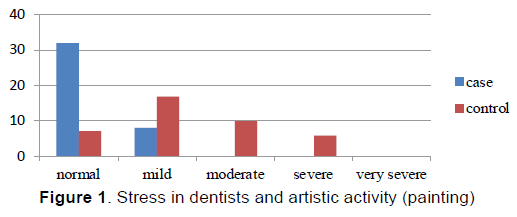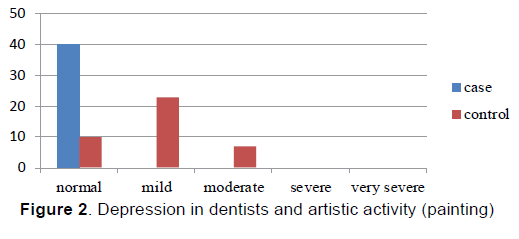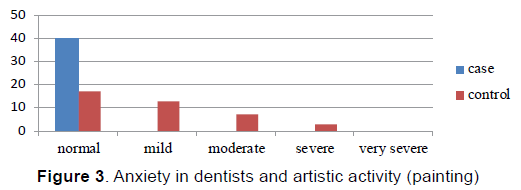Research Article Open Access
Do Dentists who are Artists have Less Stress, Anxiety and Depression than those who are not?
Nina Rahshenas1 DDS, Mohammad Hosein Kalantar Motamedi2* DDS, Mohammad Sadegh Nazari3, Kaveh Nasiri4 DDS, Omid Haj Aghaie4 DDS, Ali Nazari Nezhad3, Shahriar Shahidi5 DMD
1Department of Prosthodontics, Faculty of Dentistry, Islamic Azad University, Dental Branch, Tehran, Iran
2Trauma Research Center, Baqiyatallah University of Medical Sciences, Tehran, Iran
3Azad University of Dentistry, Tehran, Iran
5Department of Psychology, Shahid Beheshti University of medical Sciences Tehran, Iran
Visit for more related articles at International Journal of Emergency Mental Health and Human Resilience
Abstract
Objectives: The effect of art painting in reducing stress, anxiety and depression in dentists was sought in this study.
Method: Initially the list of artists who were also dentists was obtained from art societies; the names of those with artistic activity were found. We examined 80 dentists (two groups: case and controls, 40 each) from the viewpoint of stress, depression and anxiety. We visited these dentists, collected data relevant to their artistic activity and some demographic data including: age, gender, marital status, engagement in a field of specialty, existence of a stressed and depressed person in the family or history of a tragic event (divorce, death of a family member) in life. Then, a sample was taken from the non-artist group. These two groups were examined using a DASS-42 questionnaire and then the data was statistically assessed by the Mann-Whitney U -test and Chi-Square test.
Results: There was a significant difference between the two groups of dentists. Among dentists who had artistic activity (painting), 32 persons (80%) had no stress, 40 (100%) had no depression and 40 (100%) had no anxiety. However, among dentists who did not have artistic activity (painting), 7 (17.5%) had no stress, 10 (25%) had no depression and 17 (42.5%) had no anxiety.
Conclusions: Disregarding confounding variables, in this study dentist who did not have artistic activity, had more stress, anxiety and depression than dentists who engage in artistic activity (painting).
Keywords
Painting, stress, anxiety, depression, dentists
Introduction
The topic of “art therapy” has been known from the time of philosophers and thinkers such as Aristotle; but psychological application of art in its modern form was first proposed by Sigmund Freud. Soon after, art and psychoanalysis were used for mutual effects. Art therapy may help in a variety of ways. First, the aesthetic beauty of art may improve mood, vitality, self-esteem and personal awareness. Second, studies have shown that when people are deeply involved in activities that are fun, they become preoccupied and physiological indices such as heart rate (HR), blood pressure (BP) and breathing are slowed (Golin & Angel, 1991).
Factors such as the type of artistic activity, gender, profession, office location, ancillary activities and exercise are all factors that can influence stress (Argy & Kimono, 2005; Scully et al., 1990).
Stress is one of the common concerns in practice; stress, anxiety and depression in dentists (due to the risk of contracting various diseases and failure to achieve the ideal outcomes, shock, etc.) is common (Levick, 1983).
Blanca et al. studied chronic stress in dentists. In this study, stress in women was three times that in men and 13.7 % of dentists had high stress levels, 71% intermediate level of stress and 14 % had low levels of stress (Blanca et al., 2008; Makama et al., 2010; Tseng et al., 2010).
Zeyad in a study indicated that strategies for stress management must be incorporated into dental education to ensure the output of stress-free dentists (Zeyad, 2013; Alexandrina et al., 2013).
Robert et al. showed that dentists are prone to professional burnout, anxiety disorders and clinical depression, owing to the nature of clinical practice in dentistry. Fortunately, treatment modalities and prevention strategies can help dentist overcome and prevent these disorders (Robert & Charmaine, 2004).
There is an informational void regarding the impact of artistic activity on stress, anxiety and depression in physicians and dentists. Thus this study was done to assess the impact of painting in reducing stress, anxiety and depression in dentists in 2011.
Materials and Methods
First by using the dentist list of our medical association, the names of all dentists that are also artists were found; 40 were randomly selected, and 40 other dentists were selected as controls. The control group had no artistic activities. Demographics including: age, gender, marital status, and employment in the field of specialty were recorded. History of anxiety, depression and tragic events in life (divorce, death of relatives) were assessed and recorded in the information form and were exclusion criteria. Then both groups were examined using Depression Anxiety Stress Scales (DASS-42) questionnaire and assessed (this questionnaire has 42 indexes and a range of four choices; anytime, a little, sometimes, not always). Both groups were analyzed with Mann-Whitney U-test; scores were assessed according to answers and, then stress, anxiety, and depression were evaluated. According to acquired scores, they were designated as null, mild, moderate or severe and then data were analyzed with the Chi-Square test.
Results
In this study, 40 dentists with artistic activity (case) and 40 dentists without any artistic activity (controls) were studied. Mean age of the case group was 40.18 years, with a standard deviation of 4.16 years and mean age of controls was 37.27 years with a standard deviation of 1.76 years; 23 dentists in the case group were male and 17 were female. In the control group 25 were male and 15 were female.
The Chi-Square test was used to assess differences between the two groups in terms of stress. We found a significant difference between the groups (p<0.008); stress was higher in controls (Figure 1). Depression was also significantly (p<0.009) higher in controls (Figure 2) as was anxiety (p<0.001, Figure 3) (Tables 1-3).
| Indexes | stress stress rating   |
Stress | |||||
| painting | none | mild | moderate | severe | very severe | total | |
| with(case) | 6.37 ± 1.75 | 32 (80) |
8 (20) |
- | - | - | 40 (100) |
| without (control) | 18.2 ± 0.002 | 7 (17.7) |
17 (42.5) |
10 (25) |
6 (15) |
- | 40 (100) |
| test result | p<0.008 | p<0.008 | |||||
Table 1: Stress in Dentists and Artistic Activity (Painting)
| Indexes | depression rating   |
depression | |||||
| painting | none | mild | moderate | severe | very severe | total | |
| with(case) | 2.4 ± 0.62 | 40 (100) |
- | - | - | - | 40 (100) |
| without (control) | 9.7 ± 0.74 | 10 (25) |
23 (57.5) |
7 (17.5) |
- | - | 40 (100) |
| test result | p<0.009 | p<0.009 | |||||
Table 2: Depression in Dentists and Artistic Activity (Painting)
| Indexes | anxiety rating  |
Anxiety | |||||
| painting | none | mild | moderate | severe | very severe | total | |
| with(case) | 40 (100) |
- | - | - | - | 40 (100) |
|
| without (control) | 17 (42.5) |
13 (32.5) |
7 (17.5) |
3 (7.5) |
- | 40 (100) |
|
| test result | p<0.0010 | p<0.0010 | |||||
Table 3: Anxiety in Dentists and Artistic Activity (Painting)
Discussion
This study was done to investigate the relationship between artistic activity (painting) with level of stress, anxiety and depression in dentists via the DASS questionnaire. The DASS is a 42-item self report instrument designed to measure the three related negative emotional states of depression, anxiety and tension/stress. According to our findings, a definite relationship was obtained between artistic activity (painting) with the level of stress, anxiety and depression in dentists. No relationship was obtained between the demographic variables above and age or gender.
Argy et al did a study to investigate stress between students of dentistry (Argy & Kimono, 2005). In his study, he measured levels of stress between students using a standardized questionnaire. Results of his study showed that the level of stress was more in students involved in clinical work.
Blanca et al. examined factors causing stress, role of age, gender, experience, and time spent with family and duration of work on the level of stress (Blanca, Teresa, Maria et al., 2008). The method of their study was similar to our study and used standardized questionnaires. His results were similar to ours.
Robert and et al suggested that dentists must be aware of the importance of maintaining good physical and mental health. A large part of effective practice management relates to understanding stress (Robert & Charmaine, 2004). The goal of the current study was to investigate the level of anxiety and depression in both control and case groups using the Persian version of the DASS-42 questionnaire; the validity and reliability of it has been proven. Although, the results showed that level of anxiety and depression was more in the group of dentists without artistic activities.
However, it should be noted that there are many confounding factors that may also affect the mood which were not taken into account and are considered as limitations of this study.
These factors which may reduce stress include music, exercise, sports and travelling. Those who lack artistic activity and are depressed often also lack interest to travel or be entertained or take part in sport activities. They also fail to practice relaxing activities (such as meditation). Therefore this issue requires further assessment.
Conclusion
Artistic activity and duration of daily activity had a direct relationship with reduction of stress, anxiety and depression in dentists. The result of this study can be used as a functional initiative to reduce stress, anxiety and depression among dentists and personnel involved in healthcare.
References
- Alexandrina, D.U., Liviu, Z.E., Mirela, Z.E., & Mariana, P.A. (2013). The Relationship between Narcissism, Oral Health Status and Oral Health-Related Behaviors.Procedia-Social and Behavioral Sciences, 78, 496-500.
- Argy, P.O., & Kimono, D.I. (2005).Perceived sources of stress among Greek dental student.Journal of Dental Education, 69(6), 687-692.
- Blanca, E.L., Teresa, M.A., Maria, D.E., Martin, A.C., & Guillermo, J.U. (2008). Stress association factor in Mexican dentists. Brazilian Oral Research, 22(3), 223-228.
- Golin, T.H., & Angel, S.I. (1991).Introduction to painting psychology of children. 2nd ed. Tehran: Tarhenoe.
- Levick MY. They could not Talk and so they Drew: Children’s styles of coping and thinking. 1nd ed. Springfield: Charles C. Thomas; 1983.
- Makama, J.G., Amch, E.A., &Equma, S.A. (2010). Music in the operating theatre: opinions of staff and patient of a Nigerian teaching hospital. AFR Health, 10(4), 386-389.
- Robert, R.A., & Charmaine, J.O. (2004).Stress, burnout, anxiety and depression among dentists.Journal of American Dental Association, 135, 788-794.
- Scully, C., Griffiths, M., &Cawson, A. (1990).Occupational Hazards to dental staff. Illustrated Ed. London: British Dental Association.
- Tseng, Y.F., Chen, C.H., & Lee, C.S. (2010).Effect music to listening to music on postpartum stress and anxiety levels.Journal of Clinical Nursing, 19(7-8), 1049-1055.
- Zeyad, H. (2013). Academic distress, perceived stress and coping strategies among dental students in Saudi Arabia.The Saudi Dental Journal, 25, 97-105.
Relevant Topics
Recommended Journals
Article Tools
Article Usage
- Total views: 15611
- [From(publication date):
June-2015 - Jul 11, 2025] - Breakdown by view type
- HTML page views : 10892
- PDF downloads : 4719



